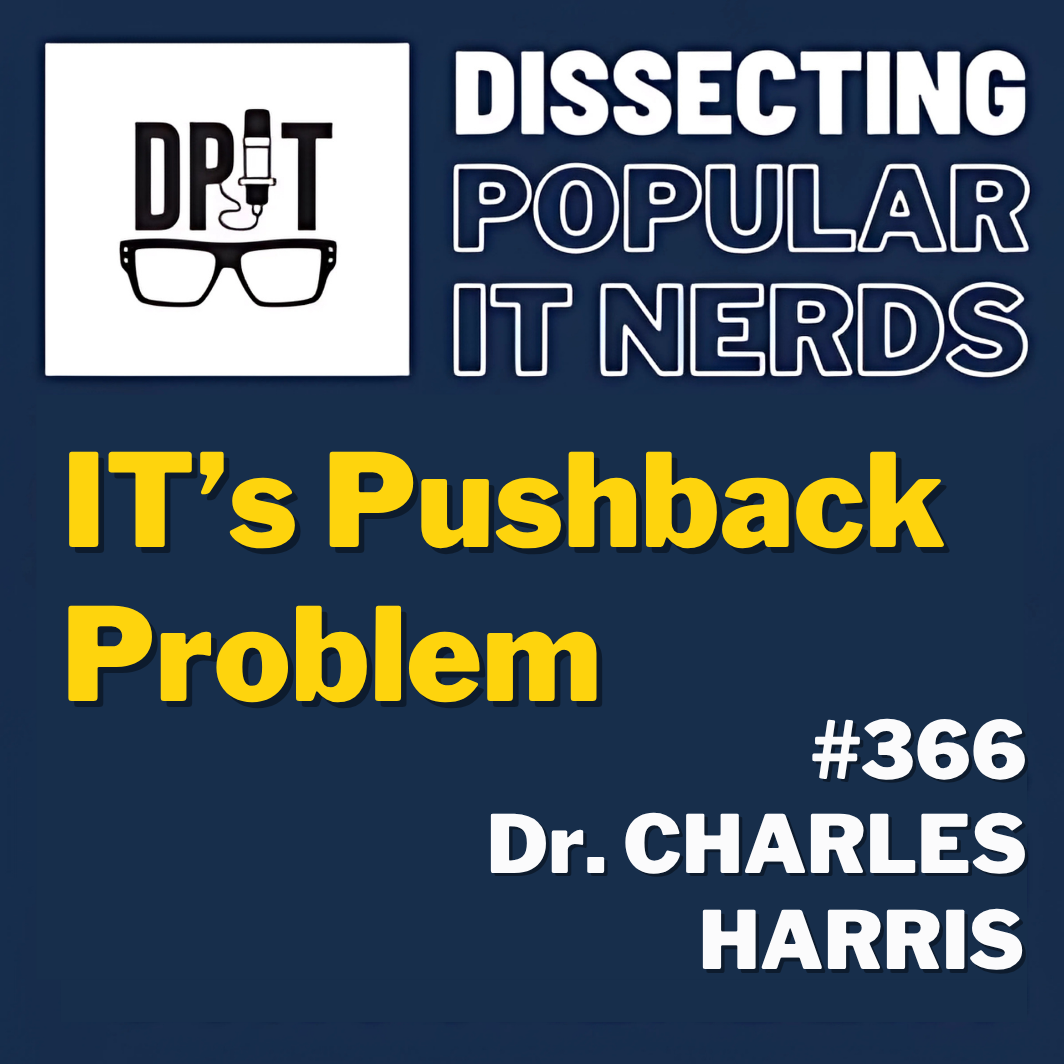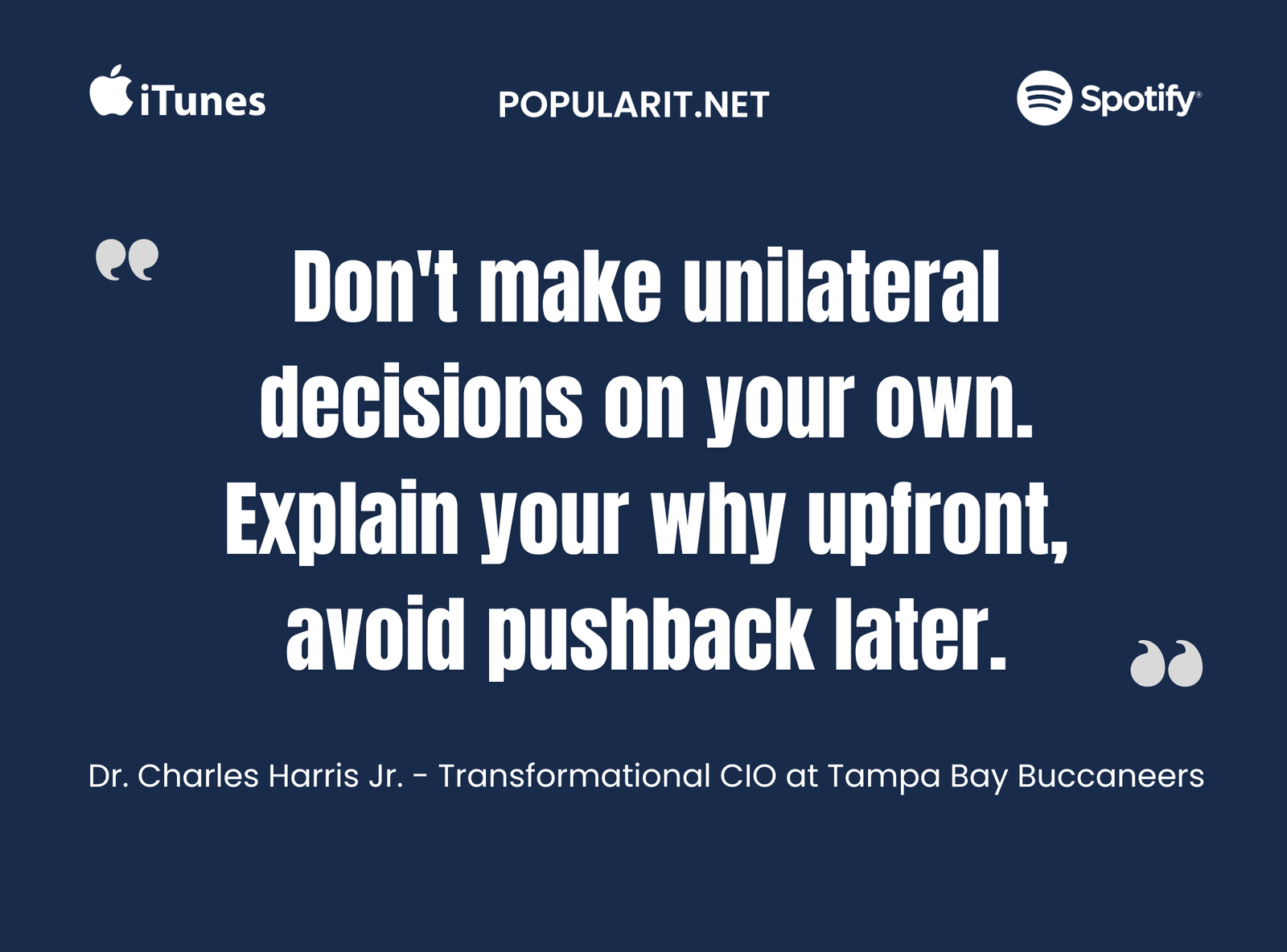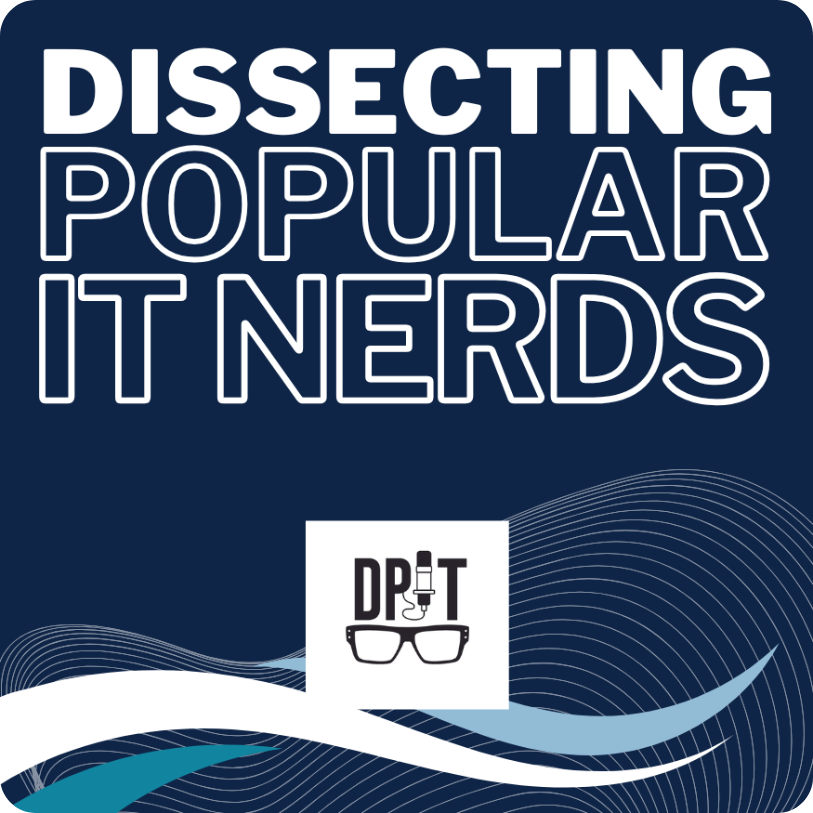Phil Howard: Welcome back to Dissecting Popular IT Nerds. I don’t know how much you know about our show, but we like to talk about IT leadership being “lonely at the top.” IT directors often face immense pressure to make everything in the company work properly for everyone. Then, they have to explain how that needs to work to the people in the boardroom or at the executive roundtable, and it’s sometimes difficult to describe what you need to accomplish.
There’s this weird seat that IT leaders sit in—we call it the loneliest seat in the business—where you have a lot of pressure on you. You’ve got a team below you that you have to support, and then you’ve got to explain and make everything happen for executive management, who don’t always understand the choices that need to be made. It’s like a doctor telling you, “Look, I need to cut this out,” and you’re questioning it. You could explain all day long, and the person is still going to be scared that you have to cut something out of them. How do you deal with that? Do you have any specific stories of how you’ve overcome this lonely role, or is it a hopeless thing for us?
Dr. Harris: That is an interesting insight, and it probably will continue to be that way. The one thing that I realized is that we are in this position for a reason; this is what we chose as our penance to the world—to be the gatekeepers of this technology thing. As it grows, there’s this level of understanding that, chances are, most of them will never get it. There is so much to juggle in this position. Where do you educate? You would almost have to give them a mini-certification-level understanding of what you need to do for them to be comfortable.
For me, it really goes around building trust. They may not understand it, but I need time so that they can trust what I say in order to progress forward. I think one of the biggest areas we have with this is cybersecurity. Even for security folks, I think it’s a pretty daunting task. I just recently got done with an NFL Conference on Security, and this conference was everything from physical to cybersecurity and everything in between. Some of that scares even me, knowing what’s out there and what the potentials are.
Being able to convey to the rest of my organization not only their level of responsibility for keeping us safe but also the needs that we have—whether it’s resources, tools, or an increased focus in certain areas—that is one of the hardest areas for me. Security is not a “set it and forget it” type of thing; it’s a constant battle you have to fight. On top of that, it’s an ever-evolving area. Whatever you thought you had covered, somebody figured out a way around it, and you have to figure out the next layer of defense. So, you definitely hit the nail on the head. It’s probably never going to go away.
Building and Maintaining Trust
Phil Howard: Let’s go back to the trust thing. We’ve talked a lot about building trust. I got hired because of trust; they trusted me for a certain amount of time, and then the trust went away. It’s almost like a shower; you have to take a shower every day. You have to bathe in this trust, or we earn people’s trust every day because so many things are happening. Executive management is bombarded with things.
How do we build trust or gain this long-standing partnership? We’ve been talking for years on this podcast about getting a seat at the executive roundtable, but it’s not really a permanent seat; it’s more of a revolving seat. The seat’s there one day and might not be there the next. How do we build that trust? Do we have to constantly be demonstrating this? Is it a public thing? Is it executive presence? How do we build that trust?
Dr. Harris: I’ve found that it’s very different for different organizations. Part of that trust, I feel, often lacks because the organization doesn’t understand the importance of technology within their organization. When you have an industry that, in its origin, was not driven by technology, its evolution begins with technology impeding the work they’re used to doing. As it increases, it’s clearly seen as an enabler, but they don’t understand the important role of the people in your IT department in continuing to enable the organization to do things like make money and market.
I’ve seen a lot of organizations where the trust is just a lack of trust in the technology, especially when you have a leadership that is not engaged in it. If you’re not engaged in it, then to you, IT and technology are just a necessary evil. I don’t think you’ll ever get to that point of building that trust because, in essence, the core of what you do is something they wish they didn’t have to deal with.
The Core Message to CEOs: Technology is Your Business
Phil Howard: You’re at a conference speaking to a bunch of CEOs. Let’s give some advice. You said they don’t understand, and sometimes technology makes jobs slower. Sometimes it is our fault; we massively overcomplicate things. Sometimes we bring in a process to do this and a process to do that, and all of a sudden, operations is this crazy, complicated process to do one little simple thing.
With that being said, what’s the advice? You’re standing in front of an audience, defending all of your IT brethren in this world. You want to tell these executives that they need to understand one thing about technology, and if they don’t, they’re going to continue to be a non-Amazon-effect company like Sears that just went under. What is the single biggest common point about technology that you would say executives and C-levels don’t understand?
Dr. Harris: Technology is your business. I don’t care what industry you’re in; it is your business. You are not able to move forward in any capacity. We are at a point now that everything from computers and databases—let’s put aside all the creative stuff—your marketing strategies, your social platforms, everything by which you are enabled, is technology. If you can’t embrace it, for just about every organization, you are going to be left behind. Even in a service industry, to accommodate for growth, what do you need? You need some form of technology. You need ease of access, ease of communication.
As things grow, you are either going to add a number of bodies, or you’re going to add technology. And I’ll tell you, the technology is most times cheaper than adding a bunch of bodies to do something. To enable that, you have to be able to partner with your technology leader to find out the best solution. Because maybe technology isn’t the answer, but they’re going to be the person who’s going to help you. A good technology person will help you manage or figure out the process that will work with the current technology you have in order to be optimized. It’s hard to get better without seeing the big picture, and from my seat, I am forced to see the big picture. I need to know what my marketing business’s job is. I need to know my salespeople’s workflow and processes. I need to know my finance people and what systems they’re using. We get to the point where we’re pulled into all the compliances involved in finance, HIPAA, everything else. This puts us in the thick of every single department. Most departments don’t have to know their counterpart’s business. We do.
Defining the “Culture of IT”
Phil Howard: So we’ve converted them. They’re a believer now. They know that technology is the business. Now they want to talk with every salesperson and everything they read in every magazine. “Hey guys, what are we going to do with AI? Are we implementing AI yet?” So how do we control this monster? Your first step sounds like we need to go through each section of the business. We need to know marketing’s workflow, what systems they’re using, and sit down with them. Do you have a methodology for how you go in and fix things?
Dr. Harris: My start is always, “What are we trying to accomplish? What problem are we trying to solve?” and keeping that focus all the way through. It’s easy in technology to get caught up in the bells and whistles and what-ifs, and us trying to do technology for technology’s sake. I want to solve a problem. I want to get better somewhere. I want to look back after an implementation and see improvement. I want to quantify it; I want some return on investment, rather than just saying, “Yes, we have AI in our organization.” I want to know what AI is supposed to do that we can’t do ourselves with what we have.
My initiative, particularly for new technology like AI, is I don’t want to be the driver. I want the business to be the driver. I want to be in the position to offer the opportunity for us to have a think tank about what exactly we are going to accomplish. I want to keep everybody grounded with what it’s going to take, what it’s going to cost, and what resources we have to not only implement but also manage it after the fact. I’m going to give you real information. But behind that, I want the business to be the driver of what you want to fix. I could see an issue that you have, but it may not be as important to you as this secondary issue that you really want to solve.
I want to offer them the opportunity to be the driver in a lot of these initiatives. But in the same hand, I want to have some type of guardrails to offer you the opportunity that whatever you’re doing, you’re investing—not me bringing you something and saying, “This is what you’re going to use.” I want you to be invested in your solution, but I need you to communicate with me to think through the entire process and say, “Is this really value-added?”
What happens a lot of times is you’ll have people in the organization that will just bring you a solution and say, “I need this. This is going to solve my problem. Here’s the solution I need you to implement.” We’ve thought through nothing. We’ve not talked about requirements. We haven’t figured out if it fits into the enterprise properly. That’s a cultural IT problem.
Phil Howard: How do you set that message? What should the culture of IT be? If you solve the culture problem, then all those other problems may fall into place.
Dr. Harris: The business is the driver. We want to say it’s a support role because it is, and our end-users are our customers. But I also want to challenge everybody to say if it’s just a support role, then we stay stuck in the cost-center mentality, when in reality, it is a business force multiplier. It should be something that…
Phil Howard: So if you’re touching every aspect of the business, if you’re sitting with every department and you know the workflow and the systems of every department, what can we do to change that cultural idea and break out of this cost-center mentality?
Dr. Harris: It goes all the way back to your earlier statement of a seat at the table. A lot of the decisions that are made, no one truly understands the interplay of technology. To have technology in the room to brainstorm alongside you on what your decisions mean… we should be the gardener of the organization. Decisions should roam through us, whether it’s people decisions, system decisions, or workflow decisions. Why? Because we’re the ones who have to go back, process that, and figure out how to enable it. What does it mean for the infrastructure? What does it mean for the data? What does it mean for security?
Technology should be alongside the CEO of an organization. The CEO’s drive is financial, the organization’s well-being, the future of the organization. We’re doing the same thing from every other level besides the people. We’re doing it for the technology to enable every portion of the organization. When you’re not a tech organization, it’s easy when you’re the Googles, the Microsofts, because you were built on tech. But when you’re a sports club, healthcare, or manufacturing, these are all businesses that existed by themselves without technology. To stay competitive now, you have to start bringing in technology. Executives and technology need to be running the organization side-by-side.
Overcoming Common IT Objections
Phil Howard: It’s almost like in sales; the salesperson knows the objection before it’s going to come. So let’s come up with a list of all the problems that every IT leader runs into.
Second-guessing: “Should we check with a third party/MSP?”
Budget issues: “It’s over budget.”
Staffing issues: “Why can’t our developer also manage the network?”
Security Complacency: “Why spend this money? We haven’t been hacked yet.”
Change Aversion: “If it ain’t broke, don’t fix it.”
Needing a Second Opinion: “I want to check with Gartner first.”
How do we prevent those from ever coming up?
Dr. Harris: For staffing, organizations often see technology as a monolith. If I hire a software developer, I guarantee you they’re asking, “Well, why can’t he manage the server or the network?” That’s not their skill set. There are specific skill sets within technology that people hone. If you hire a bunch of generalists, you’re going to have challenges because nobody’s an expert in anything. The growth of technology within an organization requires more resources to manage and optimize it.
For security, people ask, “Why should we spend all this money? We’re fine.” Or “Who cares if we do get hacked?” You’d be surprised at how often that stuff gets brought up.
For change, it’s “If it ain’t broke, don’t fix it.” That’s a great one. Just change-averse.
For second opinions, part of it is, even with those second opinions, they often don’t know what they’re looking for. It’s a trust issue. You haven’t built trust. They just want somebody to literally send a thumbs-up and say, “Yes, this is good,” with no explanation.
Major Frustrations for IT Leaders
Phil Howard: I’ve asked a lot of people over the years about their biggest frustrations. One is disparate IT silos. Another is vendors that do not jive with your team, meaning their support is terrible, and you’re held to the fire under a contract. Do you have any vendors where the support has something to be desired?
Dr. Harris: Yeah, there’s always a few, absolutely. I’m still testing the theory on this correlation, but the larger the organization, to me, the worse the service is. I have found that smaller organizations tend to be able to navigate pretty decently when it comes to interaction and support. A lot of that probably has to do with their level of support needing to be higher because they’re trying to take market share. But when you deal with a larger organization—I will not name them—they have all these different layers you have to go through. “Wait, let me get my engineer. Wait, let me get my specialist.” You’re dealing with a rep who knows nothing, and they need to be the gateway to connect all these different areas of their support. They don’t move very fast. Whereas with a smaller organization, they hire engineers that also know how to sell and support the system, so you have one frame of contact, which to me is often better.
Phil Howard: The fourth thing that IT directors struggle with, which has been the theme of this entire podcast, is training end-users. It’s the hardest thing. We’ve got to train executive management to understand why, if it’s not broke, we should still fix it. You’ve got to train end-users on a new product, and they don’t like change. What do you have to say about training?
Dr. Harris: It’s a very big part. Unless you’re doing face-to-face, forced interaction, we all see the same problems with our annual security training sessions. You have those “KnowBe4” training things that people have to watch, and they barely do it. Someone just told me the other day, “I literally do not give a crap about this.” And that’s part of the attitude. Convincing the organization of things that are not necessarily part of their day-to-day. We’re all layered with the stress of doing our job, and then here we come and tell you there are these things you need to know and be reminded of. Until something happens, you feel like it’s unnecessary or irrelevant, whether it’s security training, data privacy training, or now, AI training.
But on the other side, the training opportunities you have with the business and with end-users help broaden the relationship between IT and your expertise. It becomes the gateway to them thinking, “Oh, they know what they’re talking about. Let’s treat them as experts, not as just help desk people.” I think that often happens; it’s just, “Sit in the corner and wait until I need something, and then you should be Johnny-on-the-spot when I call you because I can’t log in or my password needs to be reset.”
Hiring and Building a Team
Phil Howard: You guys are hiring right now for a network engineer. What do you do to hire people? Is that easy or difficult?
Dr. Harris: For us, it’s not bad; it’s pretty average. We’re not short of getting resumes, I can definitely say that. Finding the skill set is always important, but my focus is always on fit. By the time a candidate gets to me, I’ve had my technical staff and some of my directors review what they see as a fit. I am looking for a much deeper fit. It’s a small team, about seven or eight people, so we do a lot with a small team.
I am often looking for team fit. I look for people who are looking to grow with the team, not somebody trying to hold a position, but somebody who’s almost entrepreneurial in what they do. Even at the level of help desk, what is your focus? Are you trying to make it better? Are you focused on workflow? Are you focusing on enhancing the process? Those are the types of attitudes that I’m always looking for. With the size of the team we have, you’ve got to learn to take ownership of the work you do and not just do it as in turning a crank, but be invested in making it the best it can possibly be.
Phil Howard: Can you teach entrepreneurial spirit? How do you teach someone, “Hey, I don’t want to have to tell you exactly every single thing you need to do”?
Dr. Harris: I’ve been trying to figure out how to make it a science. It’s the area that’s hard to create and coach. There’s a whole ecosystem to our groups. You know who the challenging one is, you know who the go-getter is, and there’s this delicate balance. You’re looking for people who are ready to jump in and help, people who know how to do their research instead of asking every single question. You can’t necessarily find it in a resume. It’s more in the dialogue, asking questions about their previous jobs and how they handled certain situations. But you can only get so much from it, and it’s almost a gamble when you bring people in.
I’ve been in discussions with universities, and I’ve been asked what they should be training in their degree programs that would be highly important. The first thing I gravitate towards is soft skills, people skills. No longer is it “sit in a corner, stay in the dark, and do the work.” It’s evolved into this very interactive role. Even for software developers, it used to be they were just behind the curtain. Now you have Agile, scrum groups, and you’re sitting with business analysts and QA folks, designing and discussing. There’s really no position in IT that doesn’t have an interactive aspect. To teach these soft skills, help them understand business acumen, and interpersonal relationships is valuable.
Learning What Not to Do
Phil Howard: What have you learned not to do? We’ll end with this. I can share first. The biggest fail I ever had… if someone tells you not to say something, and you really, really trust the person that you’re going to talk to next, don’t ever do that. People really need to be able to trust you to keep your mouth shut. I’m being very vulnerable by saying that, but you learn some things the really, really hard way when you first start as a leader. What you find out at the end is that connecting, discovering, and responding with people and being really bold and having tough conversations—the conversations that you don’t want to have—is key.
Dr. Harris: So many. From a leadership perspective, I guess mine is: don’t just make unilateral decisions on your own. Early in my career, I caught myself doing that. It’s just, “I know what’s best, I’m going to move forward,” not necessarily in a placement of needing somebody’s approval, but the better I am at communicating why and the thought process behind it, the less pushback there is on the back end.
That goes to many layers, not just for the business, but even for staff. My goal has always been for my team, whenever I come to a new team, I always ask everybody, “What is it you want to accomplish? Where do you see yourself in 3 to 5 years?” I ask that question because as we as a group accomplish what we set out to accomplish, I want to make sure I position you to accomplish what you want to accomplish. If there’s new technology and an opportunity to get into that, you’re going to be front and center. If you want to get into leadership, then I’m going to put you in positions to lead projects.
It goes to that aspect of opening the doors to communication and not being like, “I know what’s best, let’s go this way.” No, here are the reasons why and here’s how we can accomplish what we need to accomplish. It’s often helped me out more than not. Being that transparent offers the opportunity to do what we started talking about at the very beginning: building trust.
Phil Howard: Super cool. Really awesome episode. Outstanding, having a great conversation today.
Dr. Harris: Well, thank you for inviting me. I really appreciate it, this was great.



